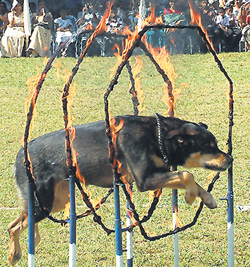
Canine cops have a lot to bark aboutOver the decades, police canines have served the public faithfully, and without expecting much in return. They have risked their lives sniffing trails left by countless criminals, thereby doing their part to uphold law and order. The official “passing out” ceremony’ of 80 dogs that had completed their training at the Sri Lanka Police Kennels Division Training Centre in Asgiriya was held recently at the Police Park Grounds. This year also happens to be 60th anniversary of the founding of the Police Kennels.
Over the past six decades some 960 canines trained to help detect criminals, drugs and explosives have graduated from the Police Kennels. Apart from their regular fight-crime duties, the dogs have also served in the North and East, giving their support to maintaining security and public safety in high-risk areas. They are often seen at checkpoints, forming part of security teams. The Asgiriya canine training institute is much like any other training facility in its emphasis on on-campus conduct. The dogs are highly disciplined and obedient to their instructors, who are specially designated police officers who have been trained here and overseas. “These dogs are trained to sniff for explosives, drugs and trails left behind by criminals,” said Lal Seneviratne, chief police inspector at the Asgiriya Police Kennels. “They pass out after a training period of six months. The group comprises Dobermans, German Shepherds, Labradors, Golden Retrievers and other world-famous detective dogs breeds.” The dogs come as gifts to the police from well-wishers, people who want to give their support to the police force. When a dog is recruited for training, due consideration is given to the animal’s breed and its hip strength (the value of a dog’s police service depends largely on the strength of its hips). After initial tests, the dog is handed over to an officer who has the task of befriending the dog over a 15-day period. The trainer then focuses on dog control and spotting any weaknesses the dog may have. This is followed by a nine-week period in which the focus is on obedience and discipline. |
|
||||||
|| Front
Page | News | Editorial | Columns | Sports | Plus | Financial
Times | International | Mirror | TV
Times | Funday
Times || |
| |
Reproduction of articles permitted when used without any alterations to contents and a link to the source page.
|
© Copyright
2008 | Wijeya
Newspapers Ltd.Colombo. Sri Lanka. All Rights Reserved. |
